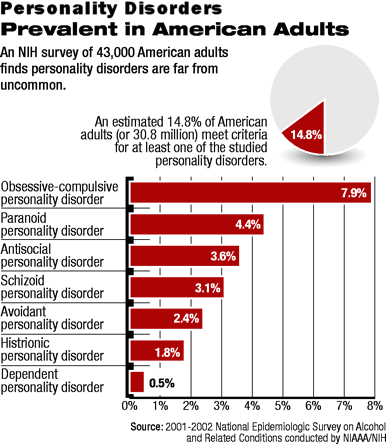Personality disorders
 A personality disorder is identified by a pervasive pattern of experience and behavior that is abnormal with respect to any
two of the following:
A personality disorder is identified by a pervasive pattern of experience and behavior that is abnormal with respect to any
two of the following:
- Thinking
- Mood
- Personal relations
- Control of impulses
It is a class of mental disorders that are characterized by long-lasting rigid patterns of thought and behavior. Because of the inflexibility and pervasiveness of these patterns, they can cause serious problems and impairment of functioning for the persons who are afflicted with these disorders.
The DSM-IV-TR: Diagnostic and Statistical Manual of Mental Disorders (currently in its fourth edition, thus the 'IV') published by the American Psychiatric Association, defines a personality disorder as an enduring pattern of inner experience and behavior that deviates markedly from the expectation of the individual's culture, is pervasive and inflexible, has an onset in adolescence or early adulthood, is stable over time, and leads to distress or impairment. It is the handbook used most often in diagnosing mental disorders in the United States and internationally.
Symptoms and effects
Although the onset of personality disorders usually occurs in adolescence or early adulthood, they can also become apparent in mid-adulthood. To some extent, the timing depends on the type of personality disorder and the situation or events surrounding the individual.
As a result, those who struggle with a personality disorder have great difficulty dealing with other people. They tend to be inflexible, rigid, and unable to respond to the changes and demands of life. Although they feel that their behavior patterns are 'normal' or 'right' people with personality disorders tend to have a narrow view of the world and find it difficult to participate in social activities. People with healthy personalities, on the other hand, are able to cope with normal stresses and have no trouble forming relationships with family, friends, and co-workers.
Personality disorders are not illnesses in a strict sense as they do not disrupt emotional, intellectual, or perceptual functioning. However, those with personality disorders suffer a life that is not positive, proactive, or fulfilling. Not surprisingly, personality disorders are also associated with failures to reach potential.
Without environmental frustration, people with personality disorders may or may not be dissatisfied with themselves. They may seek help because of symptoms (eg, anxiety, depression) or maladaptive behavior (eg, substance abuse, vengefulness) that results from their personality disorder. Often they do not see a need for therapy, and they are referred by their peers, their families, or a social agency because their maladaptive behavior causes difficulties for others. Instead of them adapting to other people, other people have to adjust to them. This creates a major strain on all relationships among family and close friends and in the workplace. At the same time, when other people do not adjust, the individual with the personality disorder can become angry, frustrated, depressed or withdrawn. This establishes a vicious cycle of interaction, causing the individuals to persist in the maladaptive behaviour until their needs are met. Because these patients usually view their difficulties as discrete and outside of themselves, mental health professionals have difficulty getting them to see that the problem is really based on who they are.
 People with severe personality disorders are at high risk of hypochondriasis, alcohol or drug abuse, and violent or
self-destructive behaviors. They may have inconsistent, detached, overemotional, abusive, or irresponsible styles of
parenting, leading to medical and psychiatric problems for their children. People with a personality disorder are less
likely to comply with a prescribed treatment regimen. Even when they do, their symptoms - whether psychotic, depressive, or
anxious - are far less responsive to drugs. Persons with personality disorders are often very frustrating to those around
them, including physicians - who have to deal with their unrealistic fears, excessive demands, sense of entitlement, unpaid
bills, noncompliance, and angry vilification.
People with severe personality disorders are at high risk of hypochondriasis, alcohol or drug abuse, and violent or
self-destructive behaviors. They may have inconsistent, detached, overemotional, abusive, or irresponsible styles of
parenting, leading to medical and psychiatric problems for their children. People with a personality disorder are less
likely to comply with a prescribed treatment regimen. Even when they do, their symptoms - whether psychotic, depressive, or
anxious - are far less responsive to drugs. Persons with personality disorders are often very frustrating to those around
them, including physicians - who have to deal with their unrealistic fears, excessive demands, sense of entitlement, unpaid
bills, noncompliance, and angry vilification.
Most personality disorders begin as problems in personal development and character which peak during adolescence and then are defined as personality disorders.
Symptoms of personality disorders include:
- As different as these disorders may sound, individuals with personality disorders have many things in common.
- Self-centeredness that manifests itself through a me-first, self-preoccupied attitude.
- Lack of individual accountability that results in a victim mentality and blaming others, society and the universe for their problems.
- Lack of perspective-taking and empathy.
- Manipulative and exploitative behavior.
- Unhappiness, suffering from depression and other mood and anxiety disorders.
- Vulnerability to other mental disorders, such as obsessive-compulsive tendencies and panic attacks.
- Distorted or superficial understanding of self and others' perceptions, being unable to see his or her objectionable, unacceptable, disagreeable, or self-destructive behaviors or the issues that may have contributed to the personality disorder.
- Socially maladaptive, changing the rules of the game, introducing new variables, or otherwise influencing the external world to conform to their own needs.
- No hallucinations, delusions or thought disorders.
Types of personality disorders
The DSM-IV lists ten personality disorders, which are grouped into three clusters:
- Cluster A (odd or eccentric disorders)
- Paranoid personality disorder
Distrust and suspiciousness in which others' motives are interpreted as malevolent. - Schizoid personality disorder
Detachment from social relationships and a restricted range of emotional expression. - Schizotypal personality disorder
Acute discomfort in close relationships, cognitive or perceptual distortions, and eccentricities of behaviour.
- Paranoid personality disorder
- Cluster B (dramatic, emotional, or erratic disorders)
- Antisocial personality disorder
Disregard for, and violation of, the rights of others. - Borderline personality disorder
Instability in interpersonal relationships, self-image and affects, and marked impulsivity. - Histrionic personality disorder
Excessive emotionality and attention seeking. - Narcissistic personality disorder
Grandiosity, need for admiration, and lack of empathy.
- Antisocial personality disorder
- Cluster C (anxious or fearful disorders)
- Avoidant personality disorder
Social inhibition, feelings of inadequacy, and hypersensitivity to negative evaluation. - Dependent personality disorder
Submissive and clinging behaviour related to an excessive need to be taken care of. - Obsessive-compulsive personality disorder
Disorder preoccupation with orderliness, perfectionism and control.
- Avoidant personality disorder
Impact and prevalence

In the USA, personality disorders affect approximately 14.8% of the adult population. That is a large number considering that there are approximately 300 million people living in the US. Therefore, 9% of the entire population would translate to over a whopping 40 million individuals in the USA alone!
At the international scale, because the DSM-IV criteria are so bound to North American cultural definitions, epidemiologic data about personality disorders in other countries are notoriously unreliable. This highlights the lack of acknowledgement to its existence around the world, much less to understand its role in our society, even as the empire of psychiatric power grows daily more all-encompassing.
Among several types of personality disorders studied, the most common personality disorder found among American adults in the large, population-based study was obsessive-compulsive personality disorder (7.9 percent, or 16.4 million people), followed by paranoid personality disorder (4.4 percent, or 9.2 million), and antisocial personality disorder (3.6 percent, or 7.6 million).
Other personality disorders affecting substantial numbers of Americans were schizoid (6.5 million), avoidant (4.9 million), histrionic (3.8 million), and dependent (1 million).
Causes of personality disorders
Personality disorders likely result from the complex interplay of early life experience, one's personality and social development, parental upbringing, as well as biological and genetic factors. They result from a complex interaction of inherited traits and life experience, not from a single cause.
In principle, genetic factors contribute to the biological basis of brain function and to basic personality structure. This structure then influences how individuals respond to and interact with life experiences and the social environment. Over time, each person develops distinctive patterns or ways of perceiving their world and of feeling, thinking, coping and behaving.
 Although little is known to date about possible biological correlates of personality disorder, individuals with personality
disorders may have impaired regulation of the brain circuits that control emotion. This difficulty, combined with
psychological and social factors such as abuse, neglect or separation, puts an individual at higher risk of developing a
personality disorder. Strong attachments within the family or a supportive network of people outside the family, in the
school and in the community help an individual develop a strong sense of self-esteem and strong coping abilities.
Opportunities for personal growth and for developing unique abilities can enhance a person's self-image. This supportive
environment may provide some protection against the development of a personality disorder.
Although little is known to date about possible biological correlates of personality disorder, individuals with personality
disorders may have impaired regulation of the brain circuits that control emotion. This difficulty, combined with
psychological and social factors such as abuse, neglect or separation, puts an individual at higher risk of developing a
personality disorder. Strong attachments within the family or a supportive network of people outside the family, in the
school and in the community help an individual develop a strong sense of self-esteem and strong coping abilities.
Opportunities for personal growth and for developing unique abilities can enhance a person's self-image. This supportive
environment may provide some protection against the development of a personality disorder.
For biologically predisposed individuals, the major developmental challenges that are a normal part of adolescence and early adulthood - separation from family, self-identity, and independence - may be the precipitating factors for the development of the personality disorder. This may explain why personality disorders usually begin in these years.
Treatment of personality disorders
Therapists have the most difficulties with those suffering from personality disorders. They are difficult to please, block effective communication, avoid development of a trusting relationship, and cannot be relied upon for accurate history regarding problems or how problems arose.
By reading the DSM-IV's definition of personality disorders, it seems that these conditions are not treatable. However, when individuals choose to be in control of their lives and are committed to changing their lives, healing is possible. Therapy and medications can help, but it is the individual's decision to take accountability for his or her own life that makes the difference.
To heal, individuals must first have the desire to change in order to break through that enduring pattern of a personality disorder. Individuals need to want to gain insight into and face their inner experience and behavior. These issues may concern severe or repeated trauma during childhood, such as abuse.
This involves changing their thinking - about themselves, their relationships, and the world. This also involves changing their behavior, for that which is not acted upon is not learned.
Then, with a support system (e.g., therapy, self-help groups, friends, family, medication), they can free themselves from their imprisoned life.




